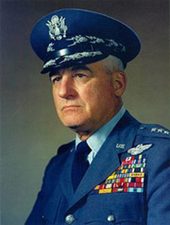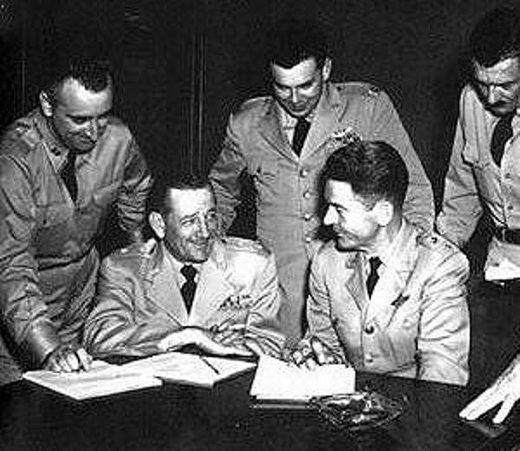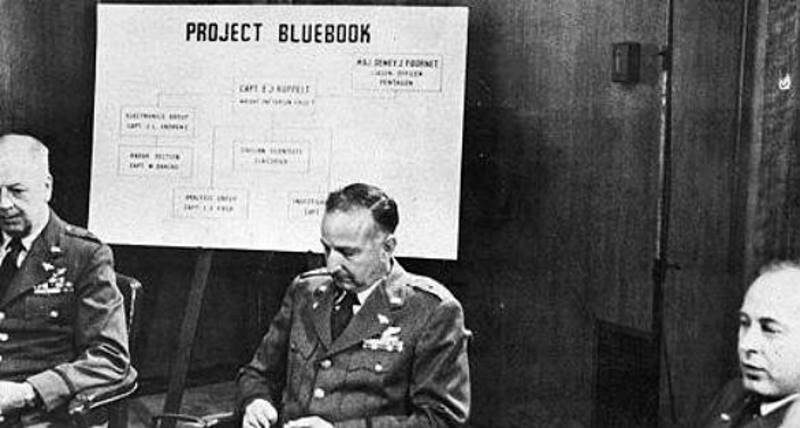But did the Air Force really shut down the project, or just move it into a private sphere where the public could be kept at arm's length? A handful of government documents have slipped out over the years pointing to the latter scenario. A look back at Project Blue Book is insightful here, for knowledge of how the project evolved remains relevant to modern assessments as well as the effort to gauge what current high-level insiders might know. Historical information indicates that the Army Air Force took serious attention to UFOs when reports of "foo fighters" started coming in from pilots during World War II. Further sightings at military installations in 1947 led to classified orders that UFO reports be sent to division offices at Wright-Patterson Air Field where General Nathan Twining was selected to oversee any type of evaluation.

A precursor to Project Blue Book, Project Sign was where Ohio State University astronomy professor Dr. J. Allen Hynek first became involved with the government study of UFOs. Hynek was contracted by the project to analyze UFO reports and determine if objects observed were misidentified astronomical phenomena. Generally skeptical, Hynek still found that roughly 20 percent of the reports could not be explained in such a manner.
In History of the United States Air Force Programs by Thomas Tulien, we learn that Project Sign's studies led to an intelligence "estimate of the situation" in the fall of 1948 which suggested that flying objects ranging from pilot Kenneth Arnold's famous Washington sighting to those witnessed by personnel at Muroc AFB, Rapid City AFB (now Ellsworth AFB), and Los Alamos Laboratory were interplanetary spacecraft (a conclusion largely based around the spectacular maneuvers reported, beyond the scope of modern quantum physics). Upper brass such as Director of Intelligence Maj. General Charles Cabell and Air Force Chief of Staff General Hoyt S. Vandenberg didn't care for that assessment however, leading to a political battle for control of the project between the Pentagon and the Air Force. This tussle was won by the Pentagon, with Project Sign ordered to send all case files to the Pentagon and USAF Scientific Advisory Board for further assessment.
Project Sign staff were soon transferred or reassigned and Project Grudge was launched in the early part of 1949, with a new staff and a directive that UFO reports could be explained with conventional reasoning. Project Grudge wasn't nearly as active in conducting studies as Project Sign, yet those pesky UFOs still refused to disappear. New project director Lt. Edward J. Ruppelt sought out Hynek again for help interpreting UFO reports, however over time Hynek's position began to evolve as he realized that the unexplained 20 percent presented a genuine scientific challenge.
Yet, General Cabell ultimately became discontent with Project Grudge's lack of substantive analysis and re-organized the project again in the spring of 1952, forming Project Blue Book. This was soon followed by one the most notable UFO incidents in American history, when a wave of sightings hit Washington D.C. in late July. Air Force Director of Intelligence Maj. General John Samford held the Pentagon's largest press conference since World War II to dismiss the sightings as a result of "temperature inversion", but President Truman meanwhile directed the CIA to start looking into the matter. This led to the formation of the Robertson Panel, which quickly came to conclusions in 1953 which were similar to that of Project Grudge in claiming there was no evidence of a direct threat to national security and that the the Air Force should work to demystify UFOs. The Panel also concluded that "the continued emphasis on the reporting of these phenomena does, in these parlous times, result in a threat to the orderly functioning of the protective organs of the body politic." This issue of government sovereignty being threatened by the existence of extraterrestrial visitors has haunted Ufology ever since (and was the subject of an academic paper "Sovereignty and the UFO" by Alexander Wendt and Bud Duvall that was first presented at The Ohio State University's Mershon Center for International Security Studies in 2006.)

While publicly the Air Force was actively trying to get ot the bottom of UFO's, privately they were utilizing Blue Book to now turn away from attempting to investigate the nature of the phenomenon and focus on the public relations issues of trying to downplay them. Hynek however was still embedded with Blue Book and did not concur with the Robertson Panel. He was determined to take on a role as an open-minded investigator, telling a gathering of physicists that "Ridicule is not part of the scientific method." And while Hynek was now trying to investigate the true nature behind these phenomena, it soon became apparent to him that the investigative methods used by others at Project Blue Book were grossly inadequate to properly investigate and analyze these phenomena. Career opportunities in the astronomy field would keep Hynek busy, yet high profile UFO incidents would continue to bring him back to Project Blue Book. Potential cases would go through an unscientific screening process before reaching Blue Book's attention and then individually selected for analysis. The majority of each investigation was then performed remotely, with Hynek as one of the only members of the project that would insist on conducting personal interviews and field investigations.
A 1966 mass UFO sighting in Michigan became a turning point for Project Blue Book when Hynek was dispatched to investigate. Under intense pressure from the Air Force and the media, Hynek suggested a swamp gas explanation at a press conference that was quickly ridiculed and which he later cited as a career low point. The subsequent publicity however put him in the public eye as a UFO expert and he successfully lobbied Congress for an unbiased scientific study of the phenomenon. But the University of Colorado study led by skeptical physicist Edward Condon was far from unbiased, with Condon reported to have been biased all along. "The Condon Committee" came to a conclusion similar to that of the CIA's Robertson Panel, declaring that UFOs were not worthy of serious study, sealing the fate of Project Blue Book and closing the government's public investigation of UFO's in 1969.
Hynek however kept moving forward, and while he was the face of the now controversial Project Blue Book, he became a strong public advocate for the continuing study of the UFO phenomenon. He published several books on the topic and introduced his "Close Encounters" classification system, which became solidified in the public consciousness when director Steven Spielberg utilized it for the title of his 1977 blockbuster film Close Encounters of the Third Kind (which featured a cameo by Hynek in the climactic ending.) Hynek also founded the Center for UFO Studies (CUFOS) and kept studying the phenomenon up until his passing in 1986.
A variety of notable experts have strongly suggested that there were other agendas to Project Blue Book and that its termination did not mark the end of government investigations and research into UFO phenomena. Prominent author and Ufologist Kevin Randle, once a special investigator with CUFOS organization, was one of the first to review Project Blue Book's declassified files in 1976 and found evidence to indicate that Blue Book was not being sent the reports on sightings that were deemed potential threats to national security. Modern Ufologist Grant Cameron, a widely recognized expert on presidential knowledge of UFOs, has suggested that the shutdown of Project Blue Book merely moved the project into the "black budget" era of deeper secrecy. Ufologist Christopher Chacon, best known as one of the world's top Anomalists, knew Hynek personally and has been continuously investigating close encounter incidents worldwide for nearly thirty years. Chacon's stint with a scientific think-tank allowed him an unprecedented access to all of Project Blue Book's files, including those that are still classified, Chacon noting the presense of multiple agendas behind Blue Book's existence and supposed termination. Historian Richard Dolan a pre-eminent expert on the topic of government secrecy surrounding UFOs, not only rebutted Edward Condon's conclusions in the Condon Committee's report, but also found sources that state many of the Project Blue Book cases were fictitious and part of a misinformation campaign. Researcher John Greenewald, best known as the creator of The Black Vault website, has become one of the top experts on Blue Book because of his intimate familiarity with the files, having acquired an incomparable collection of documents after filing more than 7,000 FOIA requests.
In the 1984 book Clear Intent by Lawrence Fawcett and Barry J. Greenwood (later re-published as The UFO Cover-Up), Hynek authored a foreword that helped shine a light on the truth of the government continuing to take UFOs quite seriously. This is proven in the book through documents obtained concerning UFO incidents up through the 1970s. Hynek took the opportunity to summarize the inherent contradiction of the government's position following the closure of Blue Book. He noted that "the authors have made revealing use of documents released through the mechanism of the Freedom of Information Act and other data which have been made available to them... which show that the CIA and NSA protestations of innocence and lack of interest in UFOs are nothing short of prevarication." Hynek goes on to reference NSA documents that were denied investigators by the courts on the grounds that they could jeopardize national security. "If this is so, then this very fact loudly proclaims that UFOs are not figments of the imagination but are, instead, quite real and of vital interest. For the government to continue to maintain that UFOs are nonexistent in the face of the documents already released... is puerile and in a sense an insult to the American people..."
It has been 48 years since Project Blue Book was officially terminated, but it's place in history, whether as a superficial-scientific study or a public relations campaign, forever transformed the UFO landscape and our culture as a whole. For good or bad, Blue Book and the fascinating possibility of UFO's captivated the country, divided the scientific and political communities and transformed the cultural landscape, producing an ongoing tsunami of questions and moreover fueling the need for answers. With such a provocative topic of scientific study that crosses-over into philosophical, psychological and sociological arenas, how could we ever not expect that we would be forever changed, no matter what results Project Blue Book produced.
The legacy of Project Blue Book lives on thanks to Hynek's post-Blue Book contributions, the FOIA, all subsequent UFO research and of course the pop culture world, which includes Spielberg's Close Encounters of the Third Kind and such recent movies as Arrival. While Project Blue Book was steeped in controversy, it undoubtedly led to an increased cultural awareness about the UFO phenomenon. Perhaps the story and legacy of Project Blue Book and that of Dr. J. Allen Hynek's rise to celebrity as a renowned astronomer who joined the project as a skeptic and left it with the belief that UFOs demand serious scientific inquiry mirrors our own place, in a world now immersed in modern technology, reminding us the need to occasionally step-back with humility and realize we don't have all the answers and be open-minded to the possibilities.
Learn more about how UFOs have been tracked after Blue Book...




Reader Comments
to our Newsletter